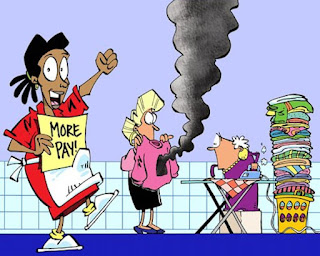A high-profile murder case kicked
off here in my local courthouse. A former police officer stands accused of
shooting a woman in her home. The case turns on the issue of self-defense. I have no involvement with the case and have no specialized knowledge about it. I have, however, fielded a number of questions about the
right to protect oneself. I’d like to devote today’s blog to a quick,
substantive overview of self-defense.
Quick
disclaimer #2: Lethal and non-lethal force have their own separate sections in
the Texas Penal Code. The general rules are the same, so I’m lumping them
together for the purposes of this column.
The Rule
A person is justified in using
force against another when, and to the degree, the person reasonably believes
that the force is immediately necessary to protect against the attacker’s use
of unlawful force.
That’s the Texas law regarding
self-defense. It seems straightforward, but volumes have been written exploring
it. We will touch upon only a few points.
1. Like
must meet like:
The response must be proportionate
to the threat. Locally, we distinguish between force and deadly force. If I
attempt to slap you, you don’t get to shoot me. And here, we open the door to a
whole bunch of “what-ifs.” That’s where the defense bar makes its living.
2. Words
alone don’t make an adequate threat.
In my jurisdiction, we have a load
of phrases we commonly call “fighting words.” The title doesn’t make them so.
I might say that I want to slap you. That doesn’t give you the right to punch
me. Some other action must accompany my words. A general fear of being
physically harmed is not enough to trigger self-defense. But see 3.
3. The
defender doesn’t have to wait.
Bullets don’t need to be flying in your direction before you are entitled to respond. The line distinguishing #2 and #3 can easily become murky. It gets resolved on a case-by-case basis. Usually, the trial testimony involves the victim making some threatening statement. He then reaches into a pocket or plunges his hand toward his waistband. Perhaps, earlier in the day, someone witnessed him loading a firearm. How much activity demonstrates an immediate threat is decided by the jurors.
4. The
defendant can’t provoke his/her use of self-defense.
I sneer and say I’m going to hit you. In response, you stand, ball your
fists, and prepare for the onslaught. I can’t let a punch fly and claim that I
was pre-empting your obvious assault. I don’t get the benefit of self-defense
if I start the trouble.
5. A
defender gets to use force until the threat is extinguished. This has a variety
of implications for the application of self-defense. If I start something and
then surrender or retreat. You don’t get to keep hitting me. Once the danger to
you is over, so is the right to protect yourself from it. But you get to
persist with your defense until the end of the perceived threat.
Often, during a murder trial, the prosecution will try
to stretch this. The government may argue that the defendant shot the victim
multiple times. Assuming the legitimacy of his right to self-defense, the
defendant is entitled to keep shooting. John Holmes, the former Harris County
district attorney, expressed the concept succinctly, “if I have the right to
shoot you dead, I have the right to shoot you dead, dead, dead, dead.” Once
legally permitted to fire, a defendant may keep firing until the threat is
extinguished. An after-the-fact claim of excessive force won’t nullify the
right.
6. Unlawful
force
A defender has a right to protect themselves from illegal contact only.
Most times, this element is a no-brainer. I don’t get to punch or shoot you.
But some contact is not illegal. Police officers get to lay hands during the
apprehension of criminals. As a society, we don’t recognize the right to fight
back. Even among civilian-to-civilian contacts, some touching is neither
harmful nor offensive, thus not necessarily illegal. I do not get to respond to
it with violence.
7. Applying
the standard
The lens through which all this conduct and counter-conduct is evaluated
is a mixed subjective/objective standard. What would a reasonable person
standing in the shoes of the defendant think? The requirement does not make
allowances for the defendant being drunk or high. Delusional thinking or
paranoia might fall under a different defense, but they aren’t a part of
self-defense. What a defendant had been told about the character of the victim
is generally admissible. That seems reasonable. If you’ve been told that I’m a
crazed murderer who wants to decapitate you, it might well influence your
perception of my actions as I approach.
8. Finally,
before using force, English common law had a duty to retreat behind castle
walls. The Castle Doctrine crossed the Atlantic with the colonists. The duty to
retreat faded as settlers moved westward. When I started practicing law, Texas
recognized that prior to deploying deadly force, a defendant had a duty to
retreat if it could be done safely unless the assault occurred in his own home. The Texas legislature
has since eliminated the Castle Doctrine. Assuming you’re someplace you’re
entitled to be and not engaged in illegal behavior, a person is free to stand
his/her ground.
There you have it. We’ve reduced a
highly contentious, oft-litigated area of the law down to eight points. The main
idea should be that self-defense in the courtroom is very fact specific. It
depends on skilled advocacy and the careful articulation of details. Cases of seemingly
similar facts may result in different outcomes. The brief summary may not be
specific enough for the reader to begin trying criminal cases, but hopefully,
it will help in digesting the morning news or plotting the next story.
Until next time.

















.jpg)











